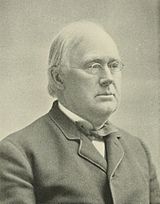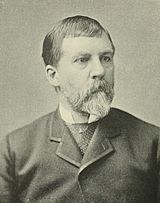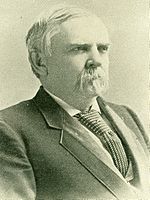Treaty of Paris (1898) facts for kids
| Treaty of Peace between the United States of America and the Kingdom of Spain | |
|---|---|
|
December 10, 1898
|
|
| Type | Peace treaty |
| Signed | December 10, 1898 |
| Location | Paris, France |
| Effective | April 11, 1899 |
| Condition | Exchange of ratifications |
| Signatories | |
| Citations | 30 Stat. 1754; TS 343; 11 Bevans 615 |
| Languages |
|
| Article IX amended by protocol of March 29, 1900 (TS 344; 11 Bevans 622). Article III supplemented by convention of November 7, 1900 (TS 345; 11 Bevans 623). | |
The Treaty of Paris of 1898 was a very important agreement. It was signed by Spain and the United States on December 10, 1898. This treaty officially ended the Spanish–American War.
With this treaty, Spain gave up its control over Cuba. It also gave Puerto Rico, Guam, and the Philippines to the United States. The U.S. paid Spain $20 million for the Philippines.
The treaty became official on April 11, 1899. This happened when both countries exchanged their signed copies. This treaty was a big deal because it marked the end of the Spanish Empire. It also showed the start of the United States becoming a major world power.
Contents
Why Did the War Happen?
The Spanish–American War started on April 25, 1898. It was caused by growing problems between Spain and the U.S. The war ended when the Treaty of Paris was signed. Spain lost control of its remaining overseas territories because of this war.
Cuba and the Philippines Seek Freedom
Many countries in Latin America had already become independent. Cuba also tried to gain its freedom from Spain. There were revolutions in 1868 and again in the 1890s. José Martí led the fight in the 1890s. He was killed in 1895.
At the same time, people in the Philippines also wanted to be free from Spanish rule. A revolt began in 1896, led by Andrés Bonifacio. Later, Emilio Aguinaldo y Famy took over. He signed an agreement with Spain and went into exile.
United States Gets Involved
Many people in the U.S. supported helping Cuba gain freedom. The U.S. also had economic interests, especially in Cuba's sugar industry. The U.S. believed it was its duty to expand its influence. This idea was called Manifest Destiny.
As the war was ending, U.S. President William McKinley gave secret instructions to his peace negotiators. He wanted Spain to give up Cuba, Puerto Rico, and other islands. He also wanted an island in the Pacific, which turned out to be Guam. The U.S. also planned to control Manila in the Philippines.
President McKinley said the U.S. went to war to help people. He stated that the U.S. did not want to conquer lands. However, he also mentioned that the U.S. had new duties in the Philippines. He saw a chance for American trade there. He wanted the U.S. to gain control of the entire Philippine archipelago.
How the Treaty Was Negotiated
The peace talks between the U.S. and Spain began in Paris on October 1, 1898. Each country sent a team of up to five people to negotiate.
Who Were the Negotiators?
The American team included:
- William R. Day, who used to be the U.S. Secretary of State.
- Senators William P. Frye, Cushman Kellogg Davis, and George Gray.
- Whitelaw Reid, a former diplomat.
The Spanish team included:
- Eugenio Montero Ríos
- Buenaventura de Abarzuza
- José de Garnica
- Wenceslao Ramírez de Villa-Urrutia
- Rafael Cerero
- Jules Cambon (a French diplomat)
A Filipino lawyer named Felipe Agoncillo wanted to join the talks. However, he was not allowed to participate.
Key Discussions and Decisions
At first, Spain wanted the city of Manila back. The U.S. had captured it after the peace agreement was signed. But the Americans refused.
For nearly a month, the talks focused on Cuba. The U.S. had promised not to annex Cuba. Spain did not want to take on Cuba's large debt. But Spain eventually agreed that Cuba would become independent. Spain also agreed to give Guam and Puerto Rico to the U.S.
Then, the negotiators discussed the Philippines. Spain wanted to keep some parts of the islands. But the American team decided that the U.S. should take control of the entire archipelago. President McKinley agreed. He sent a message saying that taking only part of the Philippines would not work.
On November 21, the U.S. offered Spain $20 million for the islands. This was much less than what some had thought it was worth. Spain's Queen-Regent, Maria Christina, accepted the offer. She did not want to start another war.
The final treaty was signed on December 10, 1898. In Spain, their legislature rejected it. But Queen Maria Christina signed it anyway, as she had the power to do so.
United States Approves the Treaty
The U.S. Senate had to approve the treaty. There were different opinions about whether the U.S. should become an empire.
 |
 |
 |
| Senators George Frisbie Hoar (left), Eugene Pryor Hale (center), and George Graham Vest (right) were against the treaty. | ||
Arguments For and Against
Most Republicans supported the treaty. Some Democrats also supported it, especially in the South. They wanted to end the war and give independence to Cuba and the Philippines.
However, some senators were against it. Senators George Frisbie Hoar and George Graham Vest were strong opponents. Hoar said the treaty would make the U.S. "a vulgar, commonplace empire."
People against the treaty argued that it went against the U.S. Constitution. They said Congress and the President could not make laws for people who were not represented.
Those who supported the treaty argued that the U.S. needed to be a world power. Senator Henry Cabot Lodge said rejecting it would make the U.S. look weak. Senator Knute Nelson believed it was America's duty to spread "Christian civilization."
Important figures like Andrew Carnegie and former President Grover Cleveland also asked the Senate to reject the treaty. They were part of the American Anti-Imperialist League.
Treaty Approval
The Senate finally approved the treaty on February 6, 1899. The vote was 57 to 27. This was just enough for the two-thirds majority needed. Only two Republicans, George Frisbie Hoar and Eugene Pryor Hale, voted against it.
What the Treaty Said
The Treaty of Paris had several key points:
- Cuba's Independence: Spain gave up all claims to Cuba. The U.S. would occupy Cuba temporarily. The U.S. Congress later passed the Platt Amendment, which gave the U.S. some control over Cuba.
- Cession of Islands: Spain gave Puerto Rico and other islands in the West Indies to the U.S. It also gave the island of Guam in the Mariana Islands to the U.S.
- Philippines Cession: Spain gave the Philippine Islands to the U.S. The U.S. paid Spain $20 million for them. Later, another treaty in 1900 clarified the exact islands included.
The treaty had 17 articles that covered many details. These included things like:
- What would happen to Spanish ships in the Philippines.
- How Spanish soldiers would leave the islands.
- The release of prisoners from both sides.
- The rights of Spanish citizens and native people in the new U.S. territories.
- Freedom of religion.
- Rules for courts and legal matters.
- Protection for copyrights and patents.
- The ability for Spain to have consular offices.
- Rights for merchant vessels.
- What would happen in Cuba after the U.S. occupation.
- How the treaty would be approved.
Challenges in the Southern Philippines
A big problem came up in the southern Philippines. Spain had given the U.S. control over three areas called sultanates. These were the Sultanate of Maguindanao, the Sultanate of Sulu, and the Confederation of sultanates in Lanao.
The issue was that Spain did not fully control these areas. The local leaders saw themselves as independent. They had agreements with Spain that were more like paying tribute than giving up control. So, Spain might not have had the right to give these lands away.
The U.S. later realized this. They fought long and difficult wars against the local people, called the Moros, from 1899 to 1913. The U.S. eventually took control of these sultanates.
What Happened Next?
Impact on the United States
Winning the Spanish–American War made the U.S. a major world power. Gaining Guam, Puerto Rico, and the Philippines helped the U.S. expand its economic influence. This had a lasting effect on U.S. foreign policy. President McKinley's role in getting the treaty approved also made the presidency a stronger office.
Impact on the New Territories
In the Philippines, people started revolting against U.S. rule in 1899. This fighting was even more intense than the war against Spain. The U.S. National Park Service noted that this delayed Philippine independence until after World War II.
In Cuba, the U.S. continued to have control even without annexing it. The U.S. government believed Cubans were not ready to govern themselves. Some U.S. senators saw these new island territories as important "outposts" for American interests around the world.
Impact on Spain: The Generation of '98
In Spain, the loss of its empire had a huge cultural impact. A group of Spanish writers and thinkers became known as the Generation of '98. They were deeply affected by these events. They criticized Spain's government and educational system. They wanted to bring new life to Spanish culture and art.
Images for kids
-
John Hay, Secretary of State, signing the memorandum of ratification on behalf of the United States
See also
 In Spanish: Tratado de París (1898) para niños
In Spanish: Tratado de París (1898) para niños




